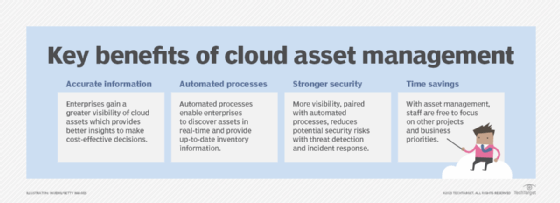5 cloud asset management best practices to optimise performance
Billing, deployment and security are all important steps of cloud asset management - these best practices can help optimise their performance
Published on 31st October 2023
User dissatisfaction with IT asset management stems largely from the difficulties associated with identifying and tracking assets that aren’t subject to central procurement or readily available for physical inventory. Most cloud users know these challenges exist for cloud assets, as well.
Many cloud services reduce the ability of central asset management to see all the assets that support cloud connection and use. This obscurity leads to a key principle of cloud asset management: Traditional asset tracking must be magnified and enhanced for cloud use.
The general goals of IT asset management (ITAM) systems include the following:
- Facilitate company accounting for -- and control of -- IT assets.
- Handle licensing, governance and other contractual issues.
- Ensure that assets are efficiently used.
Utilization efficiency has increasingly broadened to include cost management versus quality of experience, which links asset management to performance. This shift is particularly important for cloud assets because of their elastic — and somewhat ephemeral — nature. However, the performance efficiency of cloud assets demands a new look at asset tracking.
It’s possible for midsize companies to use simple tools, such as a desktop spreadsheet or database program, to organize ITAM data if their assets are on premises. However, that approach is problematic for cloud assets because of their ephemeral nature. Companies need to be able to discover assets from logs, which often contain too many transcription errors.
No matter what tools enterprises use, the right approach to cloud asset management is essential for optimized performance.
Centralize cloud billing
Enterprises can’t tag a cloud asset, inspect it for inventory or read serial numbers. But cloud assets dependably come with bills. Cloud asset management starts with the centralized collection of all cloud billing.
Remove charges for management features and other non-hosting elements. Leave charges for hosting application components or databases, as well as cloud feature usage directly linked to these elements. This set of charges is the baseline for cloud asset management, so it’s important to capture the explicit resource name and code, the nature of the resource, and the organization and individual responsible for ordering it.

Consider cloud asset security and governance
The next step is primary governance and security screening of cloud assets. Companies should validate the features of all cloud services against their security and governance policies to ensure the services don’t contain features that could compromise policies.
If enterprises haven’t done this step already, they should perform it before undertaking other cloud asset management tasks. At this point, the goal is to assess the services against general governance and security policies. Address application-specific issues later, as described below.
While cloud teams can audit cloud costs now, it’s probably better to do so when it’s possible to make associations between billed costs and applications.
Link cloud assets to applications
Next, associate cloud assets with application deployments. This step is particularly important for performance optimization.
A bill records the use of a cloud asset, while a log records the user. In some cases, cloud deployment tool logs and scripts — such as Kubernetes and DevOps — might be required to link application components to specific cloud assets and their costs. This association helps assess how resources are actually used, as it links them to specific applications and users. That association then links cloud usage monitoring with application performance monitoring (APM).
For the remainder of cloud asset management processes, the application link to the cloud establishes tracking and performance baselines.
Review licensing and pricing
The log connection is the basis for managing licenses and application costs. For each application license, the link to cloud resources and assets indicates a use or deployment that might then be regulated under software license terms. This applies not only to applications but to any middleware customers deploy in the cloud.
At this stage, enterprises should conduct application-specific security and governance reviews, as connections between cloud assets and applications are now auditable. It’s also practical to assess the pricing and billing policies now, because the link to the application is a link to the business case that justifies it.
In hybrid cloud applications, this step reveals a link between the cloud and data center for specific applications. That then requires cloud asset management practices to interlock with ITAM practices to gain complete asset visibility.
Performance optimization requires enterprises to assess cloud resource costs versus application performance levels. This step requires time-correlation of billing for cloud resources and application performance levels. Teams can derive the former from the cloud bill-to-application associations and the latter from APM tools. If ITAM procedures manage data center assets, that data can be correlated with cloud data via the common application linkage.
This is a monitoring and data analysis/correlation task, with the aim to augment traditional cloud logging and APM tools with AI tools for analysis. AI is a technology, not a goal, so it’s critical to ensure that the selected tools fit the mission optimally.
Use a combination of tools
The cloud is a target of performance analysis, so it could be a candidate for hosting some or all components of asset management. This approach has its benefits and challenges, beyond the traditional ones of comparing cost and features with what’s available for use on premises.
Cloud tools often fit the cloud provider who offers them, but they’re more difficult to adapt to other multi-cloud or hybrid cloud environments. This point is particularly important for asset management applications but is often missed when enterprises consider options.
No single tool can fit a typical enterprise’s cloud asset management challenge. A combination of tools and strong procedural controls is essential. Relying on a tool or tools without those controls is almost surely going to lead to performance, cost and governance problems.
Source
https://www.techtarget.com/searchcloudcomputing/tip/Cloud-asset-management-best-practices-to-optimize-performance












